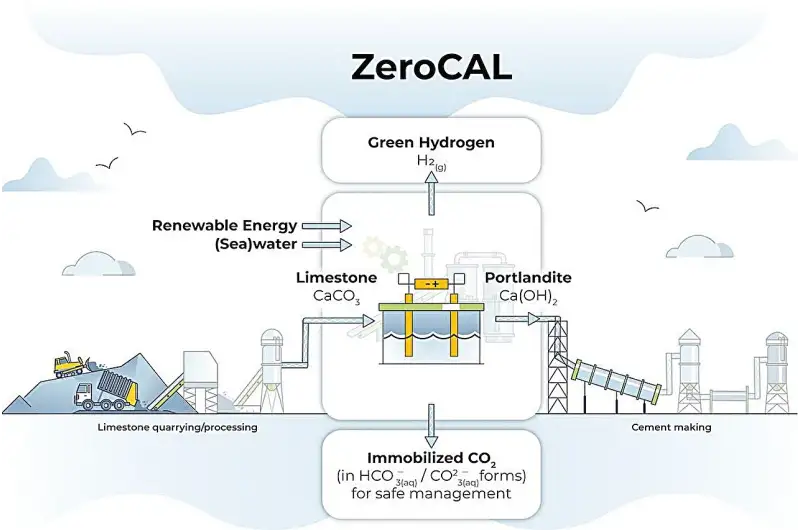Introduction: Cement’s Carbon Dilemma and the Global Call for Change
Cement is the backbone of global infrastructure. From roads to skyscrapers, it plays a pivotal role in modern construction. However, cement production is one of the largest industrial sources of carbon dioxide (CO2), contributing around 8% of the world’s total CO2 emissions. This statistic starkly contrasts with our global goals to reduce carbon footprints and combat climate change.
The process behind cement’s environmental toll is primarily the calcination of limestone, where heating limestone at high temperatures produces lime—and releases vast amounts of CO2. The urgency to decarbonize cement production has never been greater, and scalable solutions are critical to achieving net-zero emissions in the industry. The road to a more sustainable cement production process requires revolutionary shifts across the entire production chain.
Understanding the Major Emission Sources in Cement Production
Before delving into solutions, it’s important to understand the primary contributors to cement’s carbon footprint:
- Calcination Process: Responsible for over half of the CO2 emissions, this chemical reaction emits carbon from limestone.
- Fuel Consumption: Historically, coal and petcoke have been used to power cement kilns, which has resulted in a large increase in direct emissions.add significantly to direct emissions.
- Energy Use: The massive energy demand to heat the kilns further exacerbates the carbon output when using non-renewable energy sources.
With this in mind, let’s explore how the cement industry can drastically reduce its emissions through scalable, sustainable innovations.
Alternative Fuels: Powering Kilns with Low-Carbon Energy
One of the most immediate and impactful ways to reduce emissions is by replacing fossil fuels in cement production with cleaner alternatives. Conventional fuels such as coal are significant carbon emitters. In contrast, biomass, waste-derived fuels, and other renewable energy sources present a lower-carbon footprint and contribute to a circular economy by utilizing waste.
Biomass and Waste: Turning Waste into Energy
The transition to biomass—plant-based materials like wood chips or agricultural waste—presents a cleaner alternative. Similarly, waste-derived fuels, such as municipal waste or industrial by-products, are being increasingly incorporated to cut emissions by as much as 30%. These fuels not only provide thermal energy but also help reduce landfills, creating a win-win for both the environment and cement producers.
In Scandinavia, several cement plants have pioneered the use of waste-to-energy technologies, cutting their reliance on fossil fuels and achieving up to a 40% reduction in carbon emissions. These plants demonstrate how transitioning to alternative fuels can be implemented on a large scale.
Carbon Capture and Storage (CCS): Trapping CO2 Before It Reaches the Atmosphere
Even with alternative fuels, CO2 emissions from calcination remain significant. This is where Carbon Capture and Storage (CCS) becomes essential. CCS technologies capture CO2 directly from the cement plant’s emissions before it can escape into the atmosphere.
Types of Carbon Capture Solutions:
- Post-Combustion Capture: Capturing CO2 after the combustion of fuels in the cement kiln.
- Oxy-fuel Combustion: Burning fuel in an oxygen-rich environment, making CO2 easier to isolate and capture.
- Pre-Combustion Capture: Removing CO2 from the fuel before it is burned.
Once captured, CO2 can either be stored underground in geological formations or repurposed for use in other industries, such as enhancing oil recovery or creating synthetic fuels. CCS has the potential to reduce cement emissions by up to 90%, making it one of the most promising solutions for deep decarbonization.
Success Stories: Europe’s CCS Pilot Projects
In Europe, large-scale pilot projects have proven CCS technology’s feasibility. For instance, Norway’s “Longship” project is a groundbreaking initiative to capture and store CO2 emissions from multiple industrial sectors, including cement production.
Low-Carbon Cement Alternatives: Reducing Dependence on cement
One of the most significant ways to reduce the carbon intensity of cement is to develop and adopt low-carbon cement alternatives. Traditional cement is largely composed of clinker, which is produced by heating limestone and is the primary source of CO2 emissions in cement production.
Geopolymer and Slag-Based Cements: Innovative Alternatives
By replacing cement with materials like polymer cement, fly ash, and slag-based cement, emissions can be reduced by up to 60%. Geopolymer cements, for example, use industrial by-products such as fly ash (from coal combustion) and blast furnace slag, thereby reducing the need for clinker and significantly cutting CO2 emissions.
Benefits of Low-Carbon Cements:
- Lower reliance on energy-intensive clinker production.
- Utilization of industrial waste, contributing to circular economy practices.
- Reduced raw material consumption, conserving natural resources.
These alternatives are not just environmentally friendly but also possess superior durability, making them increasingly attractive for large-scale construction projects.
Electrification of Cement Kilns: Harnessing Renewable Energy
A transformative shift towards decarbonization is the electrification of cement kilns. Traditionally, kilns are powered by carbon-heavy fuels, but new technologies are making it possible to replace fossil fuel combustion with electricity generated from renewable sources.
Plasma Torches: A Revolutionary Technology
Plasma torches, for example, generate intense heat through electrically charged gases and can reach temperatures high enough to replace fossil fuels in the kiln’s heating process. With advancements in renewable energy, electricity from wind, solar, and hydro sources can drive these technologies, making the entire cement production process virtually carbon-free.
Challenges and Opportunities
Although the electrification of cement kilns is still in its infancy, pilot projects have shown promising results. Over time, as renewable energy becomes cheaper and more accessible, the electrification of kilns could become the industry standard, drastically reducing both direct and indirect emissions from cement production.
Circular Economy Initiatives: Recycling Cement Waste
The cement industry can also contribute to decarbonization through circular economy initiatives. Cement production and construction generate considerable amounts of waste, which, if recycled and reused, can reduce the demand for raw materials and lower overall emissions.
By recovering and reusing waste from demolished buildings, the industry can further reduce its environmental impact. Cement that’s reclaimed from demolition sites can be crushed and reused as aggregate in new concrete mixtures, cutting the need for new cement production.
Conclusion: A Comprehensive Approach to Decarbonizing Cement
Decarbonizing the cement industry requires a multi-faceted approach that combines innovation, investment, and a commitment to sustainability. The path forward lies in:
- Utilizing Alternative Fuels: Reducing reliance on fossil fuels by incorporating biomass and waste-derived fuels.
- Adopting Carbon Capture Technologies: Implementing CCS to trap and store CO2 emissions before they reach the atmosphere.
- Developing Low-Carbon Cements: Replacing carbon-intensive clinker with eco-friendly alternatives like geopolymers and slag-based cements.
- Electrifying Cement Kilns: Powering the cement production process with renewable electricity through innovations like plasma torches.
- Promoting Circular Economy: Recycling construction waste and minimizing raw material consumption.
Each of these strategies offers a scalable solution to the cement industry’s carbon challenges. By embracing these innovations, the industry can drastically reduce its emissions and lead the charge towards a greener, more sustainable future.
Also Read Our Recent Posts





